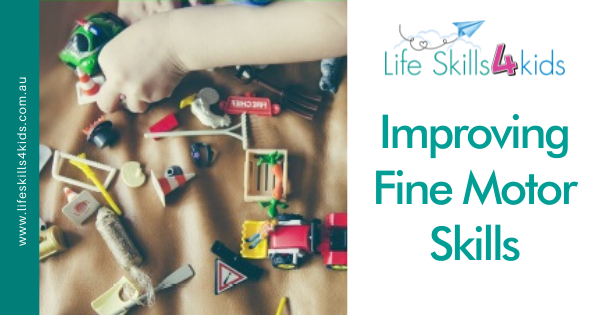Improving Fine Motor Skills
Written by Deb Hopper
Published in
Great Health Guide articles available in Audio:
CLICK HERE FOR THE AUDIO VERSION:
Sometimes it’s the little things in life that make the biggest difference and sometimes the little things in life can be the most difficult. Many children struggle with fine motor skills, or the ability to use their fingers to get the little things done. This might include doing up buttons, zips, doing up shoe laces, playing with favourite construction toys such as Lego, holding cutlery, or helping to pour themselves a drink for example.
There are three main reasons why children might find these day to day things difficult to do. These are hand and body strength, dexterity and finger co-ordination and the ability to plan what they need to do. Practicing these skills at home can be easy, fun and low cost to do. If your child continues to struggle, please contact your occupational therapist, preschool or school teacher for some more ideas.
Here are 5 top tips for making the little movements easier.
1.Sometimes a child finds it hard to control fine finger movements needed in things such as drawing or Lego because they don’t have a stable body base.
We need to have strong core postural muscles and good control of big arm movements, before we can do small movement tasks such as drawing. Body strengthening activities such as swimming, trampolining, or lying on a skate board and pushing themselves around helps children to create a strong postural core, arms and legs, to act as a solid base for finger based co-ordination tasks.
2. Sometimes children also need to strengthen their hands and arm muscles so they have the strength to open milk containers, lunch boxes or the toothpaste.
Just like adults go to the gym to strengthen our big muscles, children can also strengthen their hand muscles. For younger children, pull out the playdoh and roll snakes, pinch patterns and make snails. For older kids, they need extra resistance so try plasticine or a soft to medium strength theraputty, for hand strengthening. Or, think outside the box and get them to ‘paint the fence’. This activity is cheap and the large arm movements needed will help strengthen their arms. For strengthening little fingers, buy a cheap water sprayer and give them the job of watering the pot plants. It’s a great strengthening activity and will help you too!
3. If your child is struggling with a daily task, such as tying his or her shoelaces, help to give them the feeling of success.
Backward chaining is a great way to build confidence in fine motor skills. This means that you complete most of the task and then they do the last part. You say, ‘Well done!’ and build up their self-esteem. The next time, you do one less step and coach them in what to do, to complete the last two steps, giving praise at the end. Continue until they can do the whole task.
4. Play the ‘tell you what to do game’. This game is great for kids who struggle with planning or motor planning.
Start with bigger movements while they learn the rules of the game, for example, jumping. Get them to tell you what
their body is going to do when they do the activity, e.g. ‘jump’. For example, for jumping you need to bend your knees, put your bottom backwards, push up, jump and land. Once they get used to ‘telling’ you how to do bigger
tasks, get them to tell you how they do things with their fingers. For example, ask them to tell you how they will pick up their glass of milk at breakfast time. This could be ‘reach out, open my hand, pick up cup, move towards
my mouth, take a drink, put it back on table’. Connecting thoughts of planning words into action can help create links in the brain to make fine motor tasks easier.
5. You don’t need to buy lots of fancy toys with bells and whistles to improve motor skills. The best way to learn is to use and practise with containers, jars, lunch boxes, opening cereal boxes or helping to pack the dishwasher. If you child is finding a particular task difficult, say ‘Stop, think, breathe, what is your plan?’ Once we can stop and get a plan together, it can help to overcome feelings and responses of frustration, makes learning the task easier and creates best feedback pathways to the brain for the next level of learning.
So next time your child is struggling with something fiddly, ‘Stop, think, breathe, ask what their plan is’. Think about what fun and low cost games you can do with them, or set up for them, to make it easier next time.
Are you looking for a way to help children reduce meltdowns?
Focus better in school?
Better understand their feelings, emotions and self-regulation?
If you are searching for the answer to these questions, you have found them in this book!
This book explains how the Just Right Kids Technique can help you to teach your child to understand, recognise and learn to control their emotions and behaviour.
Designed to fit into busy schedules, the concepts in the technique are easy to understand and the strategies can be implemented straight away. Through this fun, play-based approach to learning children will gain valuable life skills that will help them to feel ‘just right’ more of the time.



